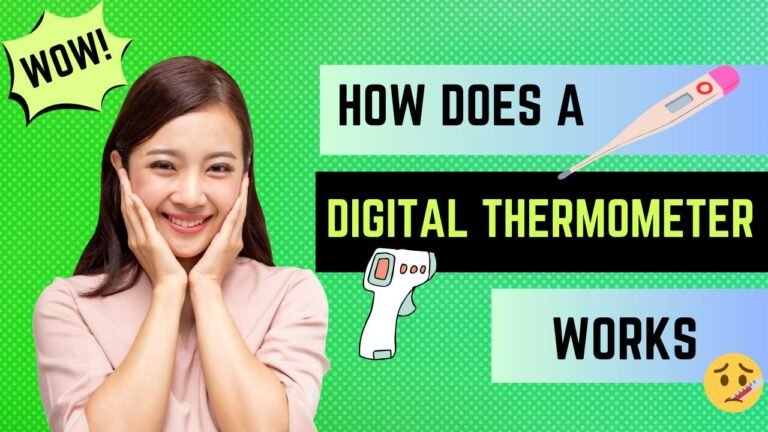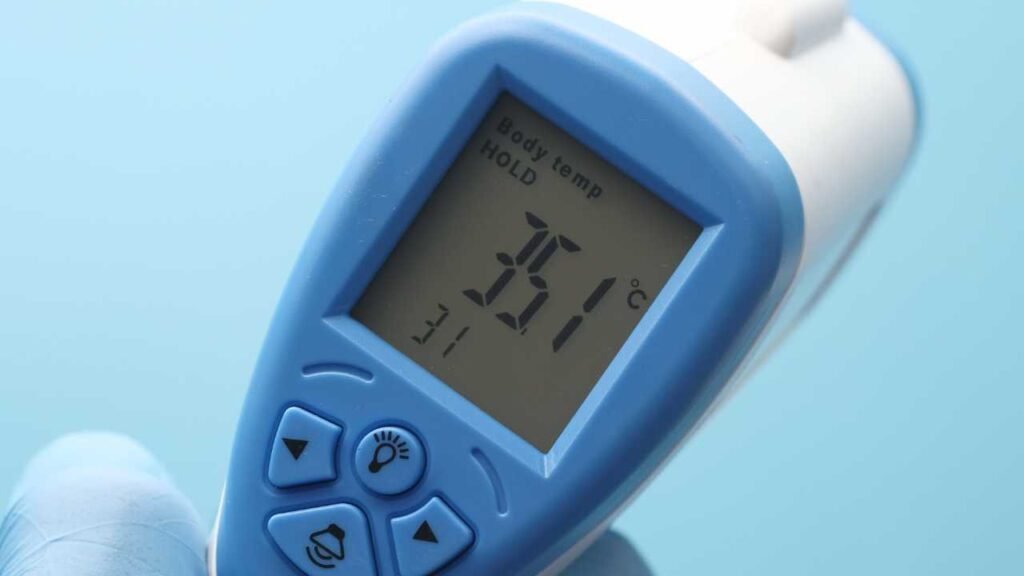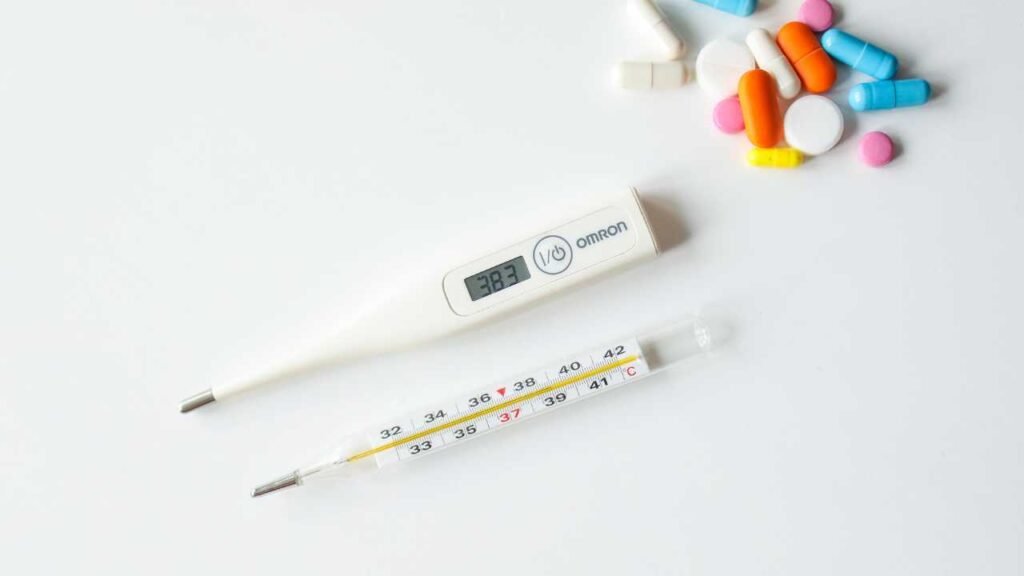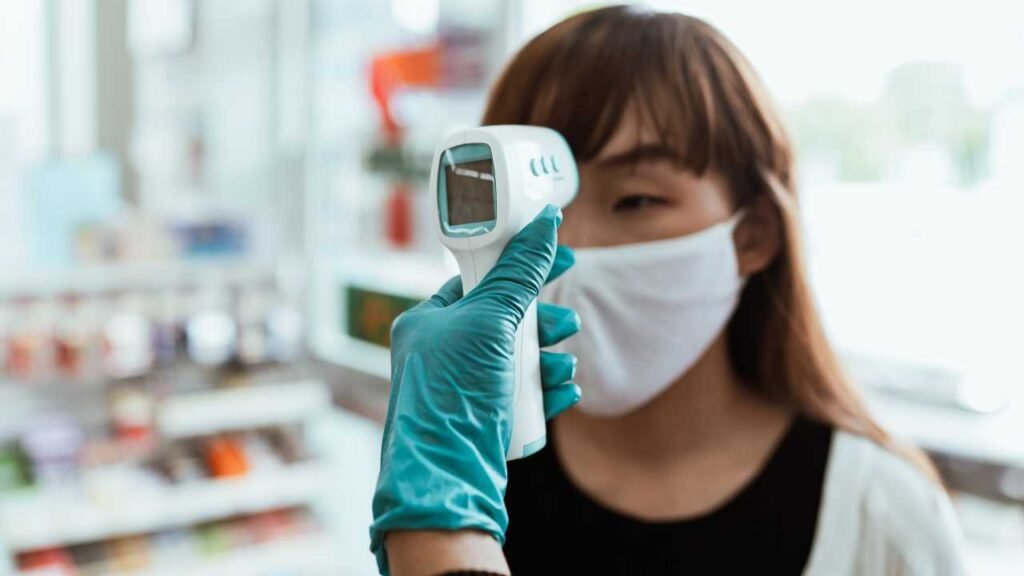Introduction to Digital Thermometers
In today’s world, where accuracy and ease of use are crucial in healthcare, digital thermometers have become essential in both hospitals and home medicine cabinets. These devices provide fast and precise temperature readings, which are important for keeping track of our health.
In this post, we’ll take a closer look at these useful tools, explaining how does a digital thermometer works and highlighting their advantages over traditional mercury thermometers.
How Digital Thermometers Work ?
Digital thermometers are like tiny computers. Instead of using mercury like traditional thermometers, they use electronic sensors to measure body temperature.
When you place the tip of a digital thermometer on a warm part of your body, the sensor detects the heat and turns it into a temperature reading on a digital screen. It’s quick, efficient, and easy to read.
Here is a step-by-step guide on their functionality:
- Sensor Activation: When activated, the thermometer’s sensor detects and converts temperature into an electrical signal.
- Signal Conversion: This signal is then converted into a digital reading by the thermometer’s built-in computer.
- Display: Finally, the result is displayed on an LCD screen, providing a clear and precise temperature reading.
Types of Digital Thermometers
Various digital thermometers are tailored for different uses and exploring these types helps you choose which would work best for your needs.
- Ear (Tympanic) Thermometers: Quick and generally comfortable, suitable for both adults and toddlers. These are popular among parents of young children, as they can quickly measure temperature without causing any discomfort.
- Forehead (Temporal) Thermometers: Non-intrusive and fast, forehead thermometers measure the heat waves coming off the temporal artery. It is non-contact and extremely rapid, ideal for screening large numbers of people.
- Digital Oral Thermometers: Common for home use, offering balance between speed and accuracy.
- Rectal Thermometers: Often used for infants for best accuracy but less comfortable.
- Flexible Tip Thermometers: Enhance comfort when a soft tip conforms to the body.
Digital thermometers come in a variety of types, each suited for a specific use. Also, each digital thermometer has its pros and cons, depending on who’s using it and how comfortable they are with the method.
Digital vs Mercury Thermometers
While many of us grew up with mercury thermometers, digital versions have largely taken over.
Here’s why:
- Safety: Digital thermometers don’t contain mercury, which is toxic.
- Speed: Digital devices provide readings much faster.
- Ease of Use: Digital readings are straightforward and easier to read than interpreting the lines on a mercury thermometer.
- Features: Many digital thermometers come with extras like memory for tracking temperature over time, fever alerts, and even smartphone syncing.
Evaluating Digital Thermometer Accuracy
Accuracy is crucial when it’s about health. Most digital thermometers are accurate within ±0.1°C or ±0.2°F. It’s always a good idea to test a new thermometer to see if it gives consistent readings. Also, check if it’s approved by relevant health authorities – this can be a good indication of reliability.
Maintaining Your Digital Thermometer
To ensure longevity and accuracy, regular maintenance of your digital thermometer is crucial:
- Regular Calibration: Follow the manufacturer’s guidance on frequency and methods.
- Battery Checks and Replacement: Power issues can affect performance.
- Cleaning and Sanitization: Use alcohol wipes to clean without damaging the sensor.
- Storage: Keep it in a protective case and in a cool, dry place.
Also read – How Propane Refrigerator Works?
List of top 10 digital thermometers
- Beurer FT 65 Multi-Functional Thermometer: This versatile thermometer offers six functions in one device. It can measure ear, forehead, and surface temperatures, as well as room temperature, and features a clock. It’s known for its quick readings and fever alarm function.
- Health Sense Thermometer: Known for its reliability and accuracy, the Health Sense thermometer features a clear digital display and user-friendly design, making it suitable for all ages.
- Ink bird ITH-10 Digital Thermometer: This compact and easy-to-use digital thermometer provides quick and accurate temperature readings, with a simple design ideal for everyday use.
- Dr Trust Forehead Digital Infrared Thermometer: This non-contact infrared thermometer from Dr Trust allows for hygienic and convenient temperature measurement. It’s designed for forehead use and offers quick results, making it great for use with children.
- DR VAKU® Infrared Digital Thermometer: The DR VAKU® thermometer is an infrared, non-contact device designed for fast and accurate readings. It’s often used for measuring body, surface, and ambient temperatures without direct contact.
- Dr Trust Waterproof Flexible Tip Digital Thermometer: Featuring a flexible tip for comfort and safety, this digital thermometer from Dr Trust is waterproof, making it easy to clean and ideal for oral, rectal, or underarm use.
- Omron Glass Mc 246 Digital Thermometer: The Omron MC 246 is a standard digital thermometer known for its accuracy and ease of use. It is suitable for taking oral, rectal, or underarm temperatures.
- Beurer FT-09 Digital Oral Thermometer: The Beurer FT-09 is a straightforward digital thermometer designed primarily for oral use. It offers accurate readings and has a basic, user-friendly interface.
- Rossmax TG380 Flexible Tip Thermometer: This thermometer features a flexible tip for added comfort and safety. It’s a digital device that provides quick and accurate readings, suitable for all age groups.
- AccuSure Highly Accurate Digital Thermometer: The AccuSure digital thermometer is praised for its high accuracy and reliability. It features a clear display and is designed for easy use, providing quick temperature readings.
Conclusion
Digital thermometers are a dynamic and essential tool in health monitoring. Whether you’re a parent looking after a sick child or just keeping one for peace of mind, a digital thermometer is a must-have in today’s health kit. It’s simple, quick, and takes the guesswork out of old-school methods.
Choose one that fits your family’s needs and rest a little easier knowing you’re prepared. Stay healthy and informed!
Also read – How Does a Microwave Work to Heat Food?
Frequently Asked Questions (FAQs)
How to Calibrate a Digital Thermometer ?
- Prepare ice water: Fill a glass with ice and add cold water until it’s full.
- Insert the thermometer: Place the thermometer into the ice water, making sure it’s fully submerged.
- Wait and read: Wait for the thermometer to stabilize, then check the reading. It should be 0°C or 32°F.
- Adjust if needed: If the reading is off, refer to your thermometer’s manual for calibration steps, as different models have different methods.
How to Use or Check Fever with a Digital Thermometer ?
- Turn on the thermometer: Press the power button to switch it on.
- Place the thermometer: Put it under your tongue, in your armpit, or rectally, depending on the type and instructions.
- Wait for the beep: Hold the thermometer in place until it beeps, indicating it’s done measuring.
- Read the temperature: Check the display for the reading. A fever is generally considered 100.4°F (38°C) or higher.
How to Change Celsius to Fahrenheit in a Digital Thermometer ?
- Turn off the thermometer: Make sure it’s completely off.
- Locate the mode button: Look for a button labeled “Mode,” “°C/°F,” or similar.
- Press the button: Hold down the button until the display changes from °C to °F or vice versa.
- Check the setting: Turn the thermometer back on to make sure the setting has changed.
How to Clean a Digital Thermometer ?
- Turn off the thermometer: Ensure it’s off to avoid any damage.
- Wipe with alcohol: Use a cotton ball or soft cloth dipped in rubbing alcohol to clean the tip and body.
- Rinse and dry: Rinse the tip with cool water and let it air dry or wipe it with a clean cloth.
- Store properly: Store the thermometer in its case to keep it clean.
How to Reset a Digital Thermometer ?
- Turn off the thermometer: Make sure it’s completely off.
- Remove the battery: Open the battery compartment and take out the battery.
- Wait: Leave the battery out for at least 30 seconds.
- Reinsert the battery: Put the battery back in and close the compartment.
- Turn it on: Switch the thermometer back on. It should be reset.
How to Change the Battery of a Digital Thermometer ?
- Open the battery compartment: Find and open the battery compartment, usually located on the back.
- Remove the old battery: Take out the old battery carefully.
- Insert the new battery: Place the new battery in, making sure the plus (+) and minus (-) sides match the markings.
- Close the compartment: Snap or screw the battery cover back in place.
- Test the thermometer: Turn it on to ensure it’s working with the new battery.
How to Fix Digital Thermometer Error ?
- Read the manual: Check the user manual for specific error codes and solutions.
- Restart the thermometer: Turn it off, wait a few seconds, and turn it back on.
- Replace the battery: Sometimes, a low battery can cause errors. Replace the battery with a new one.
- Check the sensor: Make sure the sensor is clean and not damaged.
- Contact support: If the error persists, contact the manufacturer’s customer support for further help.
Having any queries? – Do reach us at info@scivoyage.com














5 thoughts on “How does a digital thermometer works?”
Very interesting points you have mentioned, thank you for posting.Blog monetyze
I have recently started a blog, the information you provide on this site has helped me greatly. Thanks for all of your time & work.
You are my aspiration, I have few blogs and rarely run out from brand :). “Fiat justitia et pereat mundus.Let justice be done, though the world perish.” by Ferdinand I.
Важно подобрать надежный vps хрумер, который обеспечит стабильную работу программы.
Happy to join conversations, share thoughts, and pick up new insights along the way.
I like hearing diverse viewpoints and contributing whenever I can. Happy to hear new ideas and connecting with others.
There’s my site:AutoMisto24
https://automisto24.com.ua/